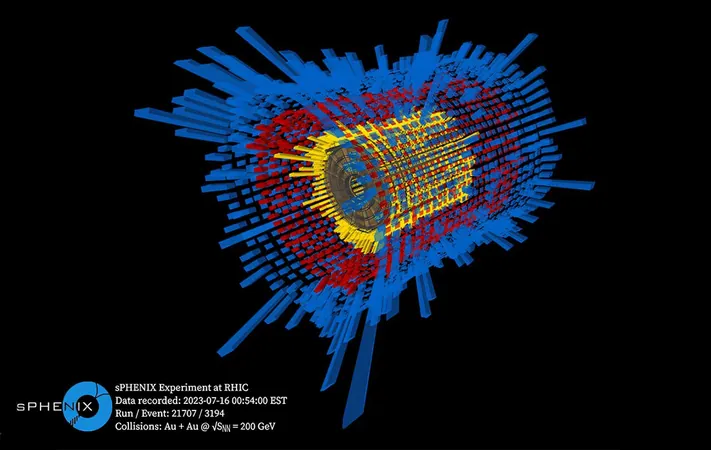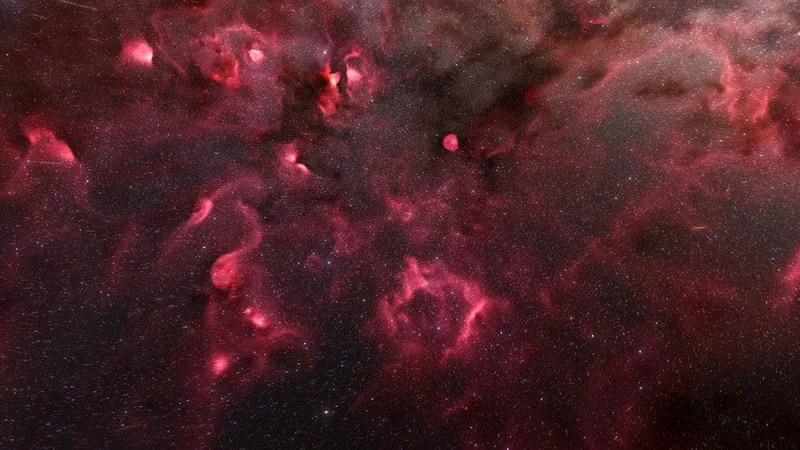
Groundbreaking Discoveries from the sPHENIX Particle Detector: Unveiling the Secrets of the Universe
2025-07-18
Author: Daniel
In an exhilarating leap for particle physics, the sPHENIX particle detector at Brookhaven National Laboratory has unveiled its first major physics results. This cutting-edge experiment, part of the Relativistic Heavy Ion Collider (RHIC), has made precise measurements of the number and energy density of thousands of particles generated from high-speed collisions of gold ions.
Revolutionizing Our Understanding of the Universe's Origins
The findings, detailed in two academic papers set to be published in 'Physical Review C' and the 'Journal of High Energy Physics', lay essential groundwork for exploring the quark-gluon plasma (QGP). This exotic state of matter, believed to have existed only moments after the Big Bang 14 billion years ago, is now within our reach for unprecedented scientific scrutiny.
The data indicates a fascinating correlation: more direct collisions produce a greater number of charged particles and generate increased energy, aligning seamlessly with previous results from RHIC since 2000. This remarkable consistency boosts confidence in the new detector's performance.
Accurate Measurements: A Game-Changer for Physics
According to Jin Huang, a physicist and co-spokesperson for the sPHENIX Collaboration, validating the detector's operation is crucial. "We need to ensure our calibration is precise and that our data-processing methods are reliable. These measurements are fundamental to assessing our detector's capabilities," he stated.
Megan Connors, a fellow co-spokesperson and physicist at Georgia State University, shares that this initial success enables them to probe deeper into their scientific objectives, particularly the intricate features of the QGP, thereby unlocking the full potential of their innovative detector.
Unlocking New Physical Frontiers
sPHENIX boasts groundbreaking features, including advanced tracking systems capable of capturing particle trajectories—even for rare particles that form and decay within mere micrometers of the collision center. Its sophisticated calorimeters measure the energy of particles produced in these cataclysmic events.
An electromagnetic calorimeter gauges the energy of light particles like electrons and photons, while a pioneering hadronic calorimeter, the first of its kind at RHIC, measures the energy of composite particles known as hadrons, which emerge in all directions.
Unraveling the Mysteries of the Quark-Gluon Plasma
"The tracking detectors act like a massive 3D camera, enabling us to visualize the paths of charged particles during intense collisions, even amid a storm of thousands of particles," explains Huang. These detectors, alongside the calorimeter, help ascertain how energetic the emergent particles are.
The combination of these components allows physicists to conduct detailed analyses. For instance, the data indicate that central collisions unleash nearly ten times more energy than peripheral ones, significantly affecting the number of charged particles produced.
This precision also empowers scientists to detect rare phenomena, such as the formation of heavy quarks right at the collision epicenter. Furthermore, they can fully reconstruct jets—concentrated sprays of particles resulting from energetic quarks or gluons.
The Future of Particle Physics Is Here
Dennis Perepelitsa, a physicist at the University of Colorado Boulder, notes that future experiments will leverage these jets as tools for investigating the QGP’s substructure. By comparing the interactions of jets generated by different types of quarks, scientists hope to reveal not just a smooth fluid of free quarks and gluons but potentially a more complex environment—"like a chunky soup instead of a smooth purée," as he aptly puts it.
These initial findings are the culmination of efforts from a dedicated team of over 300 researchers, including students and postdocs. Their hard work in building, calibrating, and analyzing data from sPHENIX marks not just a significant milestone but also the dawn of an exciting new era in the quest to understand the universe.




 Brasil (PT)
Brasil (PT)
 Canada (EN)
Canada (EN)
 Chile (ES)
Chile (ES)
 Česko (CS)
Česko (CS)
 대한민국 (KO)
대한민국 (KO)
 España (ES)
España (ES)
 France (FR)
France (FR)
 Hong Kong (EN)
Hong Kong (EN)
 Italia (IT)
Italia (IT)
 日本 (JA)
日本 (JA)
 Magyarország (HU)
Magyarország (HU)
 Norge (NO)
Norge (NO)
 Polska (PL)
Polska (PL)
 Schweiz (DE)
Schweiz (DE)
 Singapore (EN)
Singapore (EN)
 Sverige (SV)
Sverige (SV)
 Suomi (FI)
Suomi (FI)
 Türkiye (TR)
Türkiye (TR)
 الإمارات العربية المتحدة (AR)
الإمارات العربية المتحدة (AR)